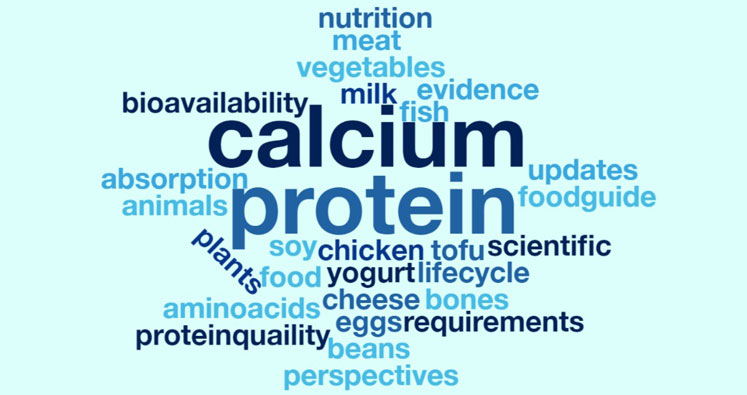Did you miss out on the 18th Annual Nutrition Forum? Read on for the highlights of the event and the perspectives of this year’s experts.
The 2018 Nutrition Forum featured three experts weighing in on the latest evidence on calcium, protein, and the implications of the draft Guiding Principles from Health Canada, which aim to inform the revisions planned for Canada’s Food Guide.
For this year’s speakers we had the pleasure of welcoming Connie Weaver, Ph.D. and distinguished professor from Purdue University in Indiana, Rachel Murphy, Ph.D. and Assistant Professor at the University of British Columbia, and a warm welcome back to Rajavel Elango, Ph.D. and Associate Professor at the University of British Columbia. Kara Vogt, Dietitians of Canada board member and dietetics educator at the University of British Columbia, acted as moderator for the event. Kara set the stage for the day’s events with a thought-provoking reflection on the progression of Canada’s nutrition guidelines from 1942 to present.
Dr. Connie Weaver:
Expert in the field of calcium research with over 400 related publications, Dr. Weaver started off the morning with her presentation, “Calcium: What is enough and how do we get it?”. Dr. Weaver brought to light her data surrounding the importance of calcium in peak bone mass (PBM) development. Just a 5 to 10% difference in PBM may result in a 25 to 50% difference in hip fracture rate later in life.
When considering the healthcare costs of hip fracture, Dr. Weaver emphasized the economic and health benefits of mitigating risk of fracture later in life through calcium intake during adolescence and early adulthood. Nevertheless, the importance of regular calcium intake throughout the lifespan to maintain bone mass was also stressed. Dr. Weaver went on to illustrate how calcium requirements are influenced by factors such as gender, ethnicity, and life stage, and the added that the best dietary sources of calcium to meet our needs are from dairy products, followed by fortified soy products.
Dr. Rajavel Elango:
Dr. Elango returned to the forum this year to present “Perspectives on Protein: An update on animal and plant-based sources” after previously presenting on his topic of passion in 2013. Dr. Elango was playful, persuasive, and pragmatic on the topic of protein adequacy, the pattern and timing of protein intake, as well as considerations of protein quality. Dr. Elango introduced his novel method of estimating amino acid utilization, and therefore protein needs, using labeled isotopes. In comparing his method to the current dietary reference intake for protein, Dr. Elango provocatively insisted that the current recommendations underestimate protein needs by approximately 30%. In response to this, and the fluctuation of global protein recommendations over the last 80 years, Dr. Elango illustrated his point of view with the memorable statement, “We can put a man on the moon, but cannot come to a consensus on how much protein to give him on Earth!”
Dr. Elango also highlighted newer methods of protein quality assessment which give cause to re-evaluate the protein content of some plant foods. The new methods have implications for plant-based diets, as one would need to more carefully select these foods inorder to get adequate protein, especially for children.
Dr. Rachel Murphy:
Dr. Murphy broadened the scope of the day’s focus to deliver a brief summary of the Canadian Nutrition Society’s (CNS) perspectives on Health Canada’s Guiding Principles. In Guiding Principle 1 (GP-1), Health Canada recommends “Regular intake of vegetables, fruit, whole grains, and protein-rich foods – especially plant-based sources of protein” and “Inclusion of foods which contain mostly unsaturated fat instead of foods that contain mostly of saturated fat”. The overall opinion of the CNS was that GP-1 lacks specificity in certain recommendations, while making generalizations in others. Dr. Murphy concluded that more consideration should be made to differences in food quality such as saturated fats and dairy products, whole versus enriched grain products, and plant-based proteins.
For full presentation slides for each guest speaker click here.
Are we finally “Getting it Right”?
Choosing an evidence-based healthy eating pattern to follow that emphasizes plant-based foods while including some animal food sources has been a topic of discussion for years. Indeed, Health Canada echoes this value in GP-1; however, in recent months much attention has been made about the anticipated new Food Guide. Health professionals, media, and members of the public have anecdotally commented on the absence of the milk and alternatives group from GP-1, which appears to have been incorporated into the protein-rich food category defined by Health Canada.
Reflecting on the previous speakers’ updates on evidence which underscores the importance of calcium- and protein-rich foods for all ages and life stages, a question arises: What are the implications for protein and calcium intake if national guidelines decide to group all protein- and calcium-rich food sources together?
So what is “Right” when it comes to eating?
Despite their differences, a subtle theme of balance, variety, and quality underlay the topics presented at the 18th Nutrition Forum.
Delivering nutrition information is a constant balancing act. Indeed, nutrients such as protein and calcium warrant attention in our food choices, however it is important to balance this with an overall focus on healthy eating patterns rather than individual foods or nutrients.
With all of these topics percolating, it comes to rest on another important question: How do we form nutrition recommendations for a diverse population that will enable them to make informed food choices without being too prescriptive?
The challenge for Health Canada and nutrition professionals is to find the balance between helping individuals make informed food choices without being too nutrient-focused. The challenge for Canadians is to find a way to apply Health Canada’s guidelines to fit their life stage, values, lifestyle, and preferences.
Putting it all together:
As Kara aptly pointed out, since the food guide of 1982 the same encompassing message holds true: eat all foods in moderation. While we deliberate, at times painstakingly over the exact amounts and the delivery, the ultimate message to Canadians is the same as ever; overall diet pattern, the quality of food choices, and the practice of moderation are key.
An enormous thank you to the guest speakers for sharing their perspectives, research, and thoughtful answers to attendees’ questions during an engaging forum.
Check out the American Institute for Cancer Research’s take on what is a plant-based diet?




